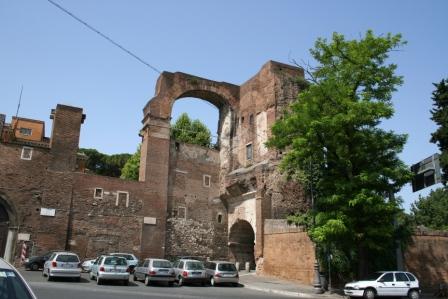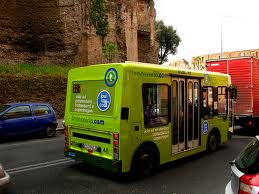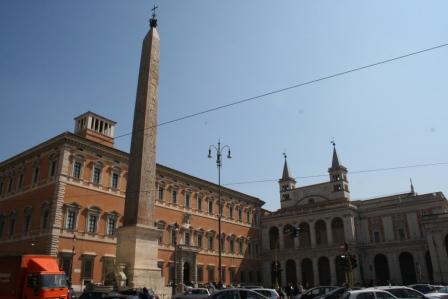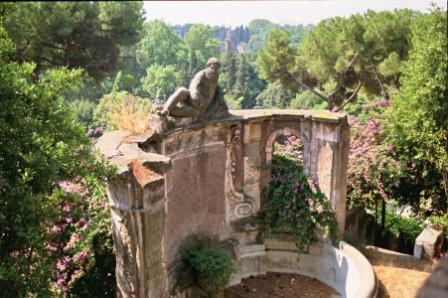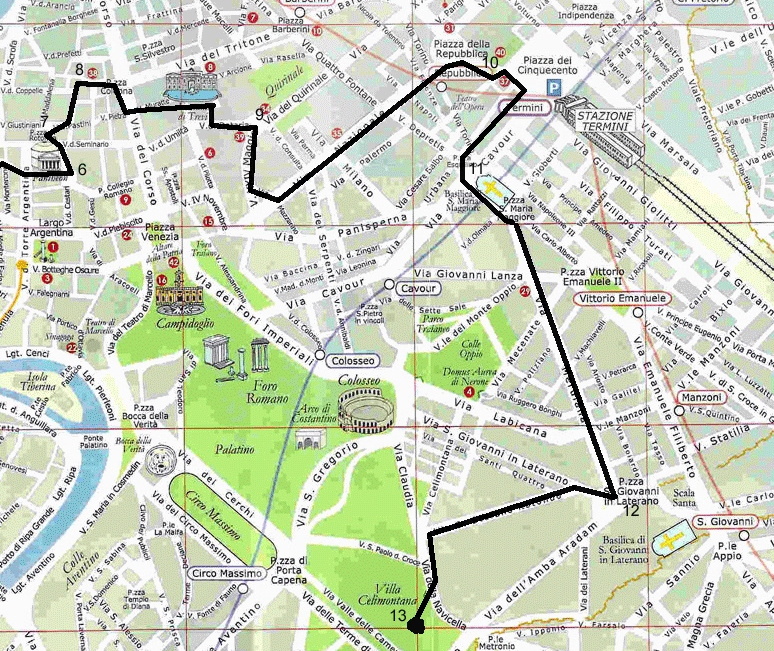
Use the links in the box below to take you quickly to each Obelisk, or some of the other places passed along the way. Click here to see a more detailed map of the route, showing the 'stops' for the bus and tram suggestions as well as the positions of the obelisks and the other main sites mentioned in the notes (opens in a new window).
8. Montecitorio Obelisk
Trevi Fountain
9. Quirinale Obelisk
Piazza del Quirinale
Via Nazionale
10. Repubblica Obelisk
Piazza della Repubblica
Termini Station
11. Esquilino Obelisk
S. Maria Maggiore
Auditorium of Maecenas
Piazza Vittorio Emanuele II
12. Laterano Obelisk
S. Stefano Rotondo
S. Maria in Domnica
13. Celimontana Obelisk
Villa Celimontana
Clivo di Scauro
Obelisk of Axum
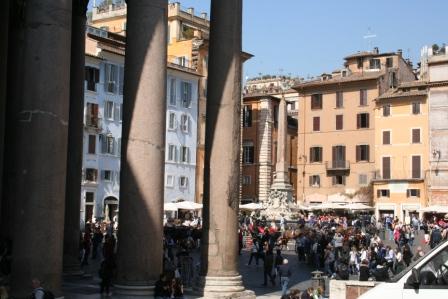
Head out of Piazza della Rotonda at the far right corner, along Via dei Pastini, which merges into Via degli Orfani. You need to follow a zig-zag route for a few streets: first pass through the Piazza Capranica, then diagonally across out along Via in Aquira (around the church of S Maria of that name), briefly into Via della Guglia (where the previous obelisk was actually found), and out finally into the next big piazza, in front not only of Obelisk #8, but also of the Italian Parliament Chamber of Deputies: the Palazzo Montecitorio.
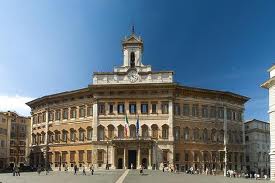
8. PIAZZA MONTECITORIO Obelisk
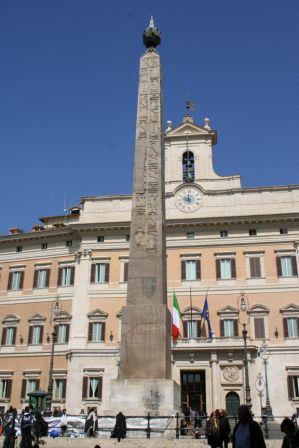
This next example has a fascinating history. It was another Egyptian original (originally…), brought over by Augustus to stand a little further north from where it is today, beside the great Ara Pacis that he had had carved - which now also stands in a different place at the top end of the Corso (the history of that monument is also very complicated, and will be described elsewhere). For once, it had a particular purpose: it was erected as the gigantic 'gnomon' of a massive sundial stretched out over the plain (Ancient Romans measured time much less precisely than we do, dividing their day into 12 'hours' from sunrise to sunset - so, as the year went by, the 'hours' themselves had different lengths. A plan to meet 'at the sixth hour' therefore meant, for us, around mid-morning: six 'hours' after sunrise). As well as indicating the date and time over a huge travertine pavement, it was cunningly placed beside the altar so that the shadow fell directly across Augustus's great family monument (and propaganda machine!) at midday on his birthday (twenty-third of September).
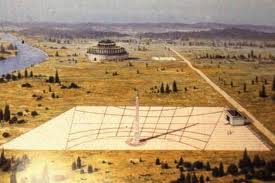
The obelisk stood until sometime around the tenth century, when it collapsed and broke into several pieces. Sixtus V had plans to dig it up and re-erect it (it would have been his fifth restoration), but it proved to be too badly damaged. However, in the late 1700s, the monument that had actually stood in this square was unearthed: this was a column, very similar to that of Marcus Aurelius in the square next door, this time dedicated to his predecessor Antoninus Pius. This too, however, proved beyond repair; but someone suggested the bright idea to Pope Pius VI of combining the remaining pieces of both spires to restore at least one of them properly. Since the obelisk didn't need the carving to be continuous, it was decided to sacrifice the column in its favour.
The stones then were reshaped and carefully joined up: you can tell which bit was from which by the absence of hieroglyphics (and a different colour). The best surviving piece of the column - its base - is kept in the Vatican Museum: interestingly, part of its carving shows this very obelisk.
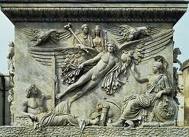
If you look at the ground between the obelisk and the palace, you can see, once again, markings inlaid into the pavement to give the obelisk back its original purpose: a bronze ball with a hole to cast a shaft of sunlight and a needle to create the appropriate shadow was placed on the top. I do not advise you to try to set your watch by it, however!
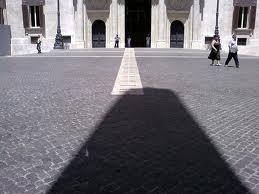
There is one final part of the story: in the cellar of a house in the nearby street of Via di Campo Marzio (number 48) still survives part of the marble paving with some of the original carving for a couple of individual days in the year, and also inscriptions for the part of the year corresponding to the star-signs of Aries, Taurus, Leo and Virgo; there is even some information about which winds to expect blowing over the Greek islands during the summer! It must have been a very comprehensive calendar.
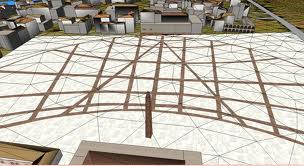
At this point on the trail, having probably drunk enough coffee for the time being, it may be time to sample a different type of refreshment from another establishment with claims to be "the best in the city". A small detour out at the far left corner of the piazza will bring you to Via degli Offici del Vicario, halfway along which on the left is Giolitti's Gelateria. The amazing confections on display here are certainly impressive, and taste pretty good too (you can probably guess what's coming!), but…you will have to wait for a different tour to discover the favourite ice-cream parlour of this website!
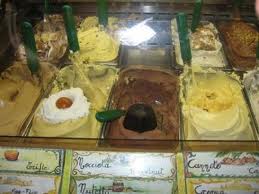
Retrace your steps to Piazza Montecitorio. For security reasons, it is no longer possible to head out by the route straight across in front of the Palazzo (I am aware I haven't actually said much about the palace itself, or its workings; frankly the obelisk is a lot more interesting!) So instead you must take Via della Colonna Antonina (leading away left with the obelisk behind you). This will bring you into Piazza Colonna. After a quick look at the column and the fountain, cross over the Corso either here or a little further down to the right, at Via di Pietra. In front of you is a street full of stalls selling calendars, prints & cards of the city: Via delle Muratte.
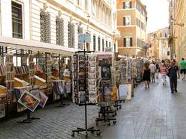
The stalls are a bit tacky, to be honest (for a better class of print you should try Piazza Borghese a little way north of Piazza Montecitorio). Anyway these peter out after a short while, and the street becomes even more distinctly geared up for tourists. There are a number of restaurants around here, probably best avoided (one of them once advertised one of its fish specials translated as 'Spigola Boiler with Tomatoes and Herpes' - yum yum!); resistible too are the overpriced souvenir and wine shops. What are they all here for? A few steps more - and there it is.
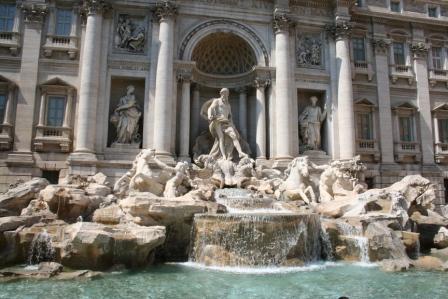
There are, once again, so many tales and descriptions of the Trevi Fountain, and (since it is not really on our itinerary today), it will be more fully written about on a different tour (see "Respighi's Rome"). Even so, I have to disagree with those who avoid it, as too crowded or garish - who cares if it is a constant haunt for tourists? It is unfair to begrudge anyone their enjoyment, and equally hard not to envy those who are discovering it for the first time. Indeed, we could have gone a different way to the next obelisk, but I can never resist even the chance just to check that it's still there…
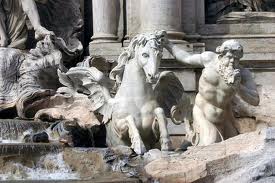
The first bar I ever visited in Rome is here - it is called, reasonably enough, the Bar 'Fontana di Trevi', and it is just ahead of you across the piazza on the corner of Via del Lavatore (no, there isn't one, sadly). It is still usually one of the first I visit on every trip. Opposite too is another decent enough place, for the sake of variety.
Head away from the fountain by taking the road out at the far right corner, Via di S Vincenzo. The church next to it (dedicated both to the road's saint and S Anastasio), thanks to its position picks up rather more visitors than its interior strictly merits; but I wonder how many of them know that its real USP is hidden away in the crypt: namely the preserved hearts and lungs of practically all the Popes for the three centuries between 1600-1900. Don't ask.
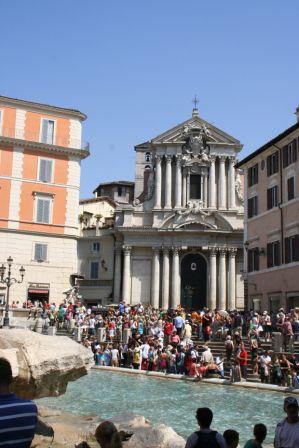
Some twists and turns to the left here lead to the area of the underground "Citta dell'Acqua" - interesting remains of early houses and conduits of the Aqua Vergine - the excavations have now re-opened after some months of conservation. You however need to take the second right, Via della Dataria. This is quite a steep climb, but not a long one: take the stairs ahead in front of you rather than following the road around, and you will find yourself in Piazza del Quirinale, in view of Obelisk #9.
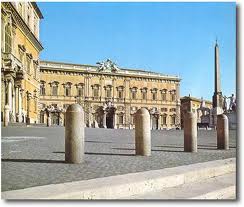
This wide, bare terrace stands in front of the Palazzo del Quirinale, for centuries the summer residence of the Popes, and now that of the President of the Italian Republic. In ancient times, the hill was the home of the Sabines, Rome's earliest rivals until their king Titus Tatius amalgamated his tribe with the men of Romulus. One of Romulus's titles was 'Quirinus' - the early citizens used to refer to themselves as 'Quirites' - and so the area took its name (possibly!) from him. In front of the palace stand Rome's tallest guards, and Bernini's long wing, known as the 'sleeve', extends much of the way down Via del Quirinale behind.
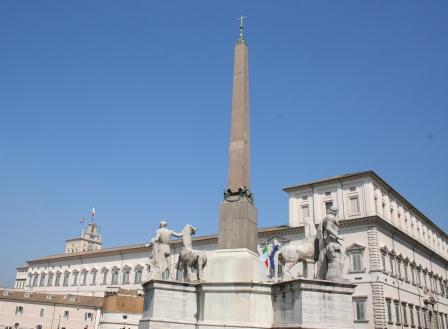
In front, either side of a fountain basin (once a horse-trough from the Forum), are two statues of the Dioscuri, Rome's twin protectors Castor and Pollux. These are Roman works, despite the attribution on their bases to a couple of Greek masters; they were found in the nearby Baths of Constantine.
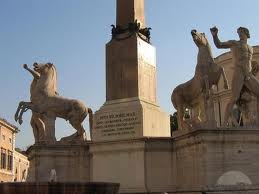
9. PIAZZA del QUIRINALE Obelisk
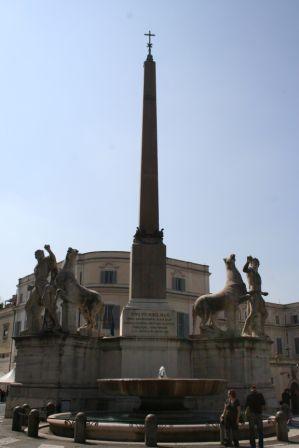
The obelisk itself is a Roman original, carved at Augustus's orders to stand in front of his family Mausoleum at the top of the Corso. This also has finally now been cleaned up, and is a very worthwhile visit. We will soon be meeting the obelisk's twin, which was re-erected earlier than this one: it wasn't until 1786 that Pope Pius VI reclaimed it and set it up here to adorn his summer palace.
If you can stretch backwards to look at the top, you may notice that the usual cone-shaped stone crown (the 'pyramidion') is missing; it is unknown whether it originally had one which was removed (or recycled) earlier. It has instead a bronze device in the shape of a cross and pointed star fixed to the squared-off stone at the summit.
Turn down the hill on the Via XXIV Maggio, where on the right you can get a tantalising glimpse of the gardens of the Palazzo Colonna where stands the site of a huge temple of Serapis, the massive stone-block remains of which are jealously guarded from your view at the top of an ever-locked stairway.
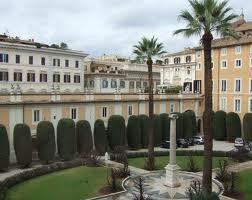
Cross over, and take a left fork down part of Via Mazzarino onto the Via Nazionale, where on the opposite side just to your right is a row of bus-stops.
The high walls above you support a small, rarely visited (and somewhat overgrown) park called Villa Aldobrandini (not to be confused with that family's magnificent country villa in Frascati). The park itself is scarcely worth the climb (apart from the view from its far balcony), but the way in (up a stairway around the corner on the lower part of Via Mazzarino) passes amongst some substantial second-century building remains. These have been identified as a warehouse, possibly connected with the Baths of Constantine complex which stood not far away - in fact, the remains of these were mostly demolished when the Via Nazionale was built.
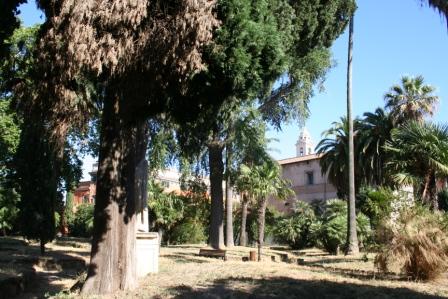
It is time you rested your feet a little on a bus-ride: the slope of the Via Nazionale (it climbs the Viminal Hill) is shallow, but wearing to walk. There are plenty of buses that will do - just make sure that the one you pick is heading to Termini (otherwise it may turn off before you want it to). If you are able to see out of both sides of the bus, first look left at the huge Palazzo delle Esposizioni: the Romans seem quite proud of this great exhibition hall - taxi drivers are always keen to point it out as they pass!
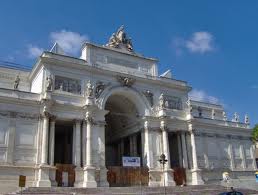
You however may feel that the strange sunken church next to it is more interesting: S Vitale dates back to the fifth century and has ancient columns supporting the portico; inside there is a wooden ceiling and rather grisly trompe l'oeil frescoes. The real eye-teaser though is the sight of how it has kept its lower ground-level position amongst all the higher more modern buildings around it.
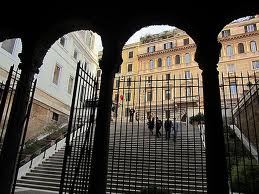
Next, on the right, look for Rome's 'Keble College' - the red stripey church of St Paul inside the Walls. This is the American Episcopal church, built in the 1870's, with mosaics by Edward Burne-Jones and ceramic designs by William Morris.
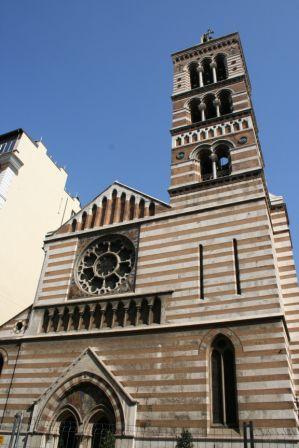
Soon now you will approach the Piazza della Repubblica, and the bus turns right. This whole area was built on the site of the Baths of Diocletian, truly gigantic even by the standards of some of the later emperors' constructions. The complex stretched from some surviving halls to your left, open again to visit, with a wonderful restored courtyard by Michelangelo full of ancient sculpture, all the way to Termini Station ahead (named, of course, after the 'Terme' themselves).
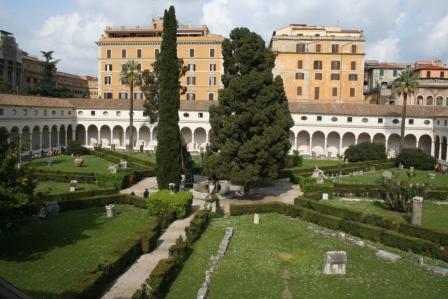
Several nearby churches were built over parts of their foundations, or incorporated still-standing sections of their walls (this part of the city will be described in more detail on a future 'tour').
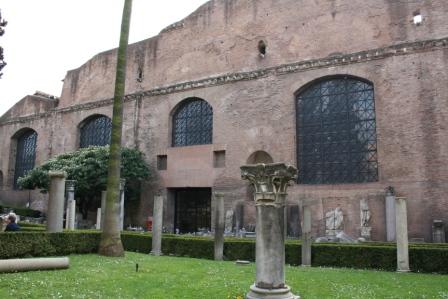
For now, just enjoy the exuberant Fountain of the Naiads, built in the circular area of the baths' main exhedra (the square is still called 'Piazza dell'Esedra' by older residents).
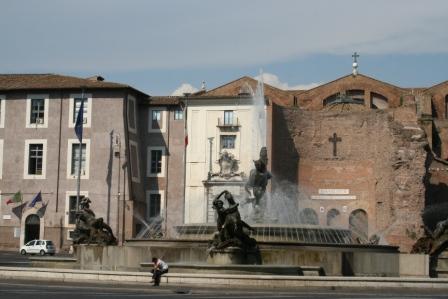
It is said that the figures of the water-nymphs (added to an existing fountain) were modelled on a pair of sisters, the musical stars of their day (it was built in 1901); but because the statues were thought to be too scandalous, a wooden fence was put up around the fountain while it was debated whether or not to reveal them to public view. Of course, this was too tempting to the young men of Rome, who overnight pulled the fences down and unveiled the statues anyway.
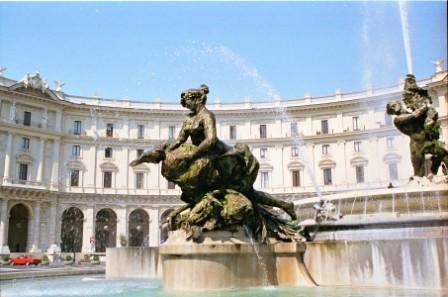
Get off the bus at the first stop around the corner. Ahead stands, in Palazzo Massimo alle Terme, the most important of the four sites of the Rome National Museum - for a future visit. Turn back and cross the road: by now you can probably see Obelisk #10; but go back to the corner and walk around, on Viale Einaudi, up to its side facing the main road - not only for a better view of the dedication, but also because this sadly is not the most salubrious part of the city: the monument (particularly the area behind it) can sometimes be home territory to some of Rome's shadier elements. This however should not deter you from getting a proper look at the spire itself.

10. PIAZZA della REPUBBLICA Obelisk
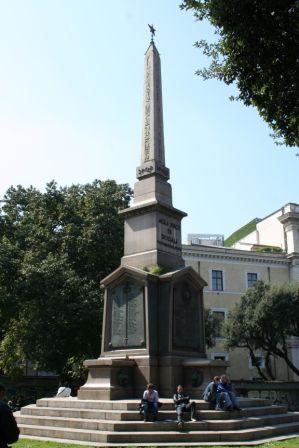
This spire is the 'twin' mentioned before of the obelisk that used to stand in the grounds of the Villa Medici before being shipped over to Florence, where it now decorates the Boboli Gardens. A copy, you may remember, was made of that one, which is in the Villa Medici today. This one was the last of the currently standing obelisks to be unearthed: the archaeologist Lanciani discovered it in 1883, being yet another of the spires originally standing at the Temple of Isis in the Campus Martius. Originally it had come from Heliopolis, and it still bears inscriptions to Rameses II.
It was decided by the Italian authorities (the days of Papal rule being over) to use the spire as a monument to commemorate the Italian troops who died as a result of an ambush by the Ethiopians at Dogali in Eritrea - the troops had been sent in support of an Italian-ruled town that had been attacked early in 1887. Its first position was more centrally in front of Termini Station - the huge square there also being named in honour of the 500 men who died; but it was relocated to its present site here to the side in 1924. One can't help feeling that this was rather a pity: thousands of people now pass it each day without even noticing that it is there.
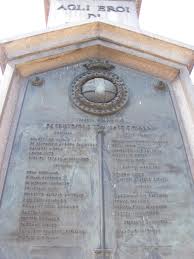
Probably this is the place to say something, too, about Termini Station itself. There are few rail terminuses (too confusing to write the 'official' plural!) that are busier or, actually, more exciting in the whole of Europe. I have travelled to and from it on many occasions, and visited it, too, when not even needing to go anywhere, for a reason I shall mention shortly. Its history spans the years of the Second World War - although there was a station there before, Mussolini had a grand design for it (and not just to make the trains run on time…); after the war however his massive fascist-style architecture blueprint was thrown out in favour of the striking wave-like cantilevered façade you see today. It is one of the few successful modern buildings in the city.
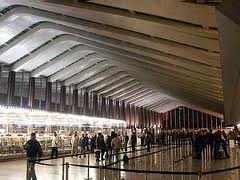
The two Metro lines intersect beneath the main-line area, in a wonderful space where you can get lost for hours, wandering amongst lots of cafes, shops and other unexpected corners; it has airport style moving walkways to take you to some 'hidden' platforms, passing a chapel on your way; a three-storey bookstore; and (you can already tell I love the place, but here's the clincher) a terrific newly-opened 'Food & Lounge' on the top floor, with dozens of franchise outlets serving every type of cuisine imaginable. Eating out at the city's main rail-station is perhaps one of this site's stranger recommendations, but it is recommended nonetheless.

Our next two targets are to be found in front of two of Rome's most important churches (2, indeed, of the 'Seven Churches of Rome' - see a future tour!) To get to each, some form of transport is recommended. The first is somewhat nearer - practically visible from where you are; in fact, it may well take you just as long to travel there on a seat as it would on foot (probably about 10 minutes). I offer you the choice! To walk there, go back to your last bus-stop, walk to the end of that road, then turn right down Via Viminale, and take the fourth turn on the left: Via Torino. This will bring you to the square you want, Piazza dell'Esquilino.
Alternatively, walk up to the vast transport terminus known as Piazza dei Cinquecento (the 500 soldiers killed at the Battle of Dogali) in front of Termini Station and catch a 75 bus. It will take you down Via Cavour to the same square.
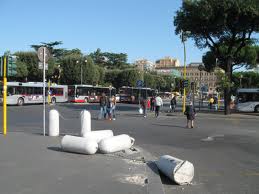
A further option is to get on a tram, either numbers 5 or 14: you will easily see the tram platforms again in the direction of Termini. These however take you along Via Farini, one block away from the square: you will have to walk around the corner to get back to the Piazza you want.
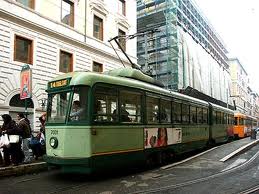
By whichever route you get there, Piazza dell'Esquilino is home to the Basilica of S Maria Maggiore, the fourth in rank of the four Patriarchal basilicas. Its interior (the one of the four which best preserves the proper shape of an ancient Roman basilica) contains many treasures, as well as chapels built for Sixtus V and Paul V - it will be described in more detail on the future 'tour'. Outside, it has a wonderful campanile, the tallest in Rome; at its front stands the single intact surviving column from the Basilica of Maxentius in the Forum. Crowning the Esquiline Hill, the whole church is said to have originated on a spot indicated by a miraculous midsummer fall of snow - visit on August the fifth and you will be showered from above with white rose petals in remembrance. At its back (or apsidal) end stands Obelisk #11.
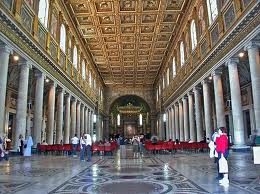
11. PIAZZA dell' ESQUILINO Obelisk
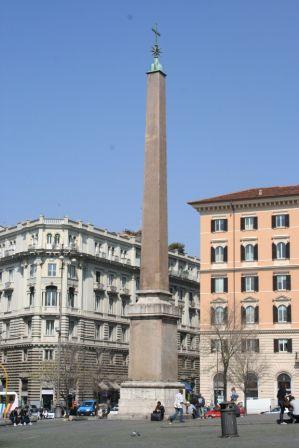
There are a couple of possible reasons why Sixtus V decided to erect the obelisk at the back of the church, rather than in the position of honour at the front. One is that here it in fact stood at the entrance to his own hilltop palace, the Villa Montalto.
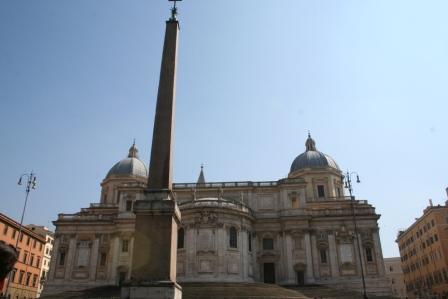
The other, probably more important, is that it coincided more exactly with the great criss-cross vantage points across the city that the Pope had created with the erection of some of his other monuments. His overall plan was to connect the seven churches with long straight roads, punctuated with obelisks at the important junctions: for instance, his 'Strada Felice' (as it was intended to be called, after his pre-papal name) would travel from his obelisk at Piazza del Popolo, taking in the Trinita dei Monti along the way (although of course the obelisk there was put up much later), to here at Piazza dell'Esquilino - and then continue to one he never got round to putting up in front of S Croce in Gerusalemme. On a map this can be readily seen to fit very nicely. (We will shortly be travelling up the 'Via Gregoriana' - by a more modern name - to Obelisk #12).
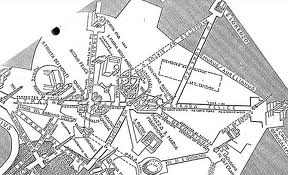
Probably both of these explanations counted equally. Anyway, the obelisk he had raised here was the 'twin' of the one we saw standing not long ago at the Quirinale (remember, that also wasn't put up until later, but it was almost certainly in Sixtus's mind to have one there outside the Papal summer residence). It had again been commissioned by Augustus for his Mausoleum, and was rediscovered in 1527. This was Domenico Fontana's second project after the success in St Peter's Square, being set up in 1587, showing the importance Sixtus gave to this particular church. As with its twin, the top of the shaft lacks a pyramidion, being squared off and crowned instead (by Sixtus) with another pointed star and cross, as well this time as a strange arrangement of cones which is supposed to represent the hills of the 'Monti' rione.

From here, unless you seriously want to set off on a long and tedious walk up a not very interesting street, this time I really do recommend a bus-ride. Walk around to the main entrance of the Basilica: practically level with the column (on the right facing away), just before the junction with Via dell'Olmata, you will find the bus-stop for Bus 714.
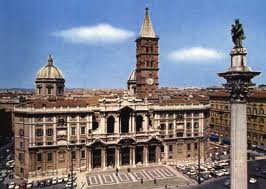
This will take you along Via Merulana (the old Via Gregoriana). One landmark to look out for as you travel is the covered remains, on the corner of Via Leopardi (left side), of the so-called Auditorium of Maecenas. This important figure was Augustus's 'Minister of Culture'; he owned sumptuous estates across the city, including here on the Esquiline Hill. This sunken hall (which is no longer very easy to visit) is usually thought to be a sort of "recitation theatre" (hence its name) for the likes of poets such as Virgil and Horace, who were well liked by Augustus and enjoyed the support of Maecenas as their patron. More recently however - and less evocatively - it has been identified as possibly just one of Maecenas's garden dining-rooms (which is not to say that poetry recitations might still not have gone on there as well).
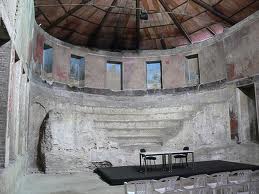
Incidentally (since this is only a short walk from the Auditorium), you are very close to another of Rome's weirder locations in Piazza Vittorio Emanuele. This is the site of the strange "Porta Magica", a monolithic doorway-to-nowhere flanked by two intimidating statues of the Egyptian god Bes and inscribed with alchemical symbols and messages. Its history is a little disappointing however, and I'm not going to spoil the mystery just now! It also stands next to the remains of a huge monumental fountain from the time of Alexander Severus (second century), usually called '"The Trophies of Marius" (it was from here that these marbles were taken to their current position on the balustrade of the Capitoline Hill).
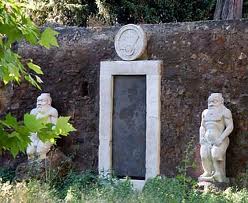
The square itself, once a seriously dodgy hang-out for druggies and worse (the curse of V Emanuele strikes again!) has recently been given a facelift - not that it has particularly made it any more attractive. It is a shame too that the lively North African clothes, spice and food markets which used to surround it have been moved away.
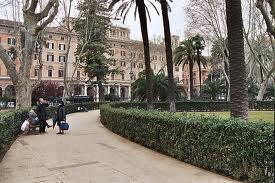
Having mentioned all this, if you'd had time on your hands you could have got off the bus at Largo Leopardi and "done" these two locations last mentioned; at the Piazza here is an eponymous Metro Station via which you could just as conveniently have travelled on to our next destination….it's up to you if you want to make the detour.
So - if you haven't arrived here on the Metro (or walked…!) the 714 will bring you to the corner of Piazza di San Giovanni in Laterano: the true Cathedral of Rome (rather than the Vatican's S Pietro). Once again a future tour will describe the great Basilica's history and interior in more detail; you are here to see now though the oldest and tallest obelisk of them all, having been given a full restoration, in the square in front.
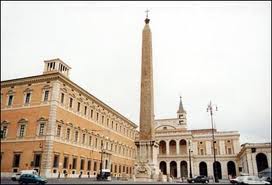
12. S GIOVANNI IN LATERANO Obelisk
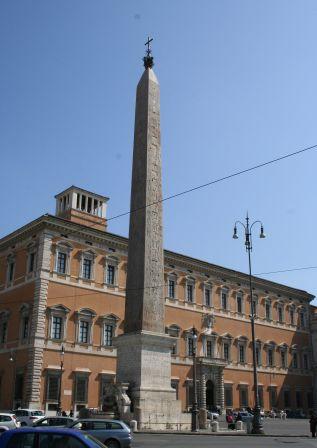
This magnificent red granite spire started life in the fifteenth century BC in Egypt, raised by Tutmoses III to stand in front of the Temple of Amon at Thebes in honour of his father. Eighteen centuries later, the emperor Constantine planned to move it to adorn his new city of Constantinople, by then the capital of the Empire. This however never happened. Instead, his son, Constans I, had it shipped to Rome, and set it up on the spina of the Circus Maximus, where it joined the one Augustus had placed there earlier (which you may remember now stands in Piazza del Popolo).
Over the course of the intervening years it collapsed and was lost in the mud of history, having at one point even been struck by lightning and broken into pieces. It was once again Sixtus V and Fontana who had it dug up and repaired, siting it here in front of the great Cathedral of Rome where the equestrian statue of Marcus Aurelius had stood: it was at this time that this was moved to stand on the top of the Capitoline Hill. Sixtus had it crowned with a bronze "bolt" to commemorate the lightning-strike, and with the project's completion in 1588 it was Fontana's third success (making the Piazza del Popolo spire the last of Sixtus's monuments).
Inscriptions were carved in honour of the God of the Christians, to redeem it from its pagan past; there is also a short but dignified chiselled sentence honouring Fontana.
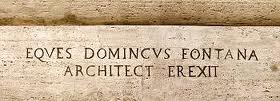
This has been the crowning point of our trail, but before we reach the end there is one final spire to see. To reach the last obelisk of the trail, it is a good time to take another bus - the little electric bus 117 has (since 2019) been reinstated, and runs from here in the Piazza, opposite the obelisk, along the road we need to take next. On the way we can decide if we want to stop off halfway to visit another of Rome's more unusual churches.
So, whether by bus (or Shanks's pony if you prefer - it's not an arduous walk but beware fast traffic), we start off along the long, narrow, almost countrified road known as Via di S Stefano Rotondo. The large complex to the left is a hospital, and there are ancient remains of an aqueduct running along the road on the right. The important church after which the road is named is set back to the left in its own attractive gardens after about 10 minutes' walk from the Piazza (or a little way further on from the first stop on the 117).
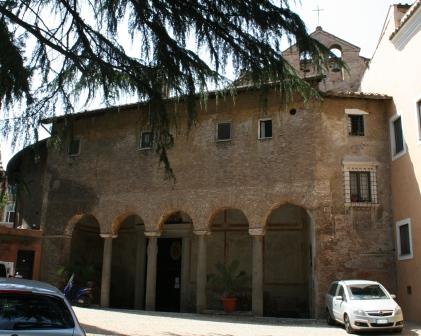
S Stefano Rotondo is definitely worth a visit. As its name implies, it is unusual in being built on a circular plan. For a long time this shape was attributed to its being constructed over the remains of an ancient market-building, the "Macellum Magnum" dating to the time of Nero. This is not now thought to be the explanation, although it is unclear what is; remains of a temple of the Eastern soldiers' god Mithras have been found beneath it, and certainly it is very old - one of the oldest round Christian churches in the world, in fact: its first Christian dedication has been dated to the time of Pope Simplicius in the 470s.
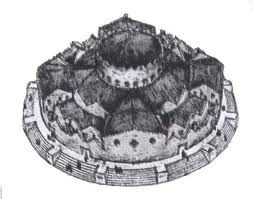
Originally there was one more circle of columns, with four outstretching arms in the shape of a Greek cross. Three of these and the outer row of columns were pulled down by Pope Nicholas V in the 1400s; inside (it has recently been restored, rather coldly) is a wooden throne, said to have been that of Pope Gregory the Great; and an extraordinary set of frescoes covering practically half of the inner wall, showing scenes of the various gruesome ways some of the famous Saints were martyred - not for the squeamish!
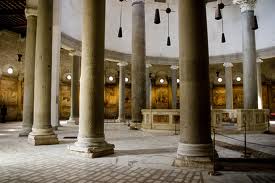
Back outside, continue to the end of the road. Then turn up to your left; in the middle of the road stands a detached arch of the Aqua Claudia aqueduct, and past this, a little fountain in the shape of a boat standing in front of the church of S Maria in Domnica.
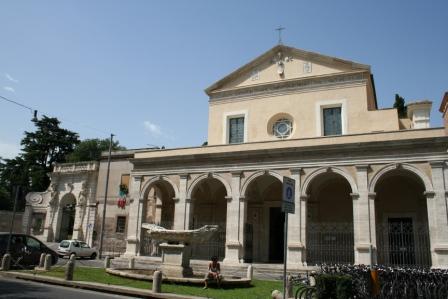
The boat fountain gives the street its name - "…della Navicella". Both it and the church were restored by Pope Leo X in the 1600s, although the church itself is originally much older. Several explanations are given for its name: it may simply be a corruption of the title 'Domina' (lady or mistress). It is a delightful little place - the almost rustic portico sets the tone, and inside it is equally attractive, with some bright and colourful frescoes and (slightly arcane) ceiling decorations. The old large granite columns do nothing to spoil the pleasant effect.
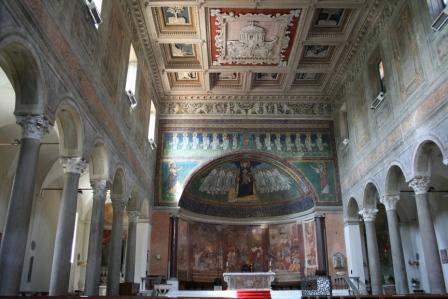
Outside again, around just to the left of it stands the gateway to the lovely park where our final target resides. This is the Villa Celimontana, named after the Caelian Hill (possibly the second-least-known hill of the 'Seven', beaten into last place only by the Viminal!) It has many shady corners, home to lizards and green parakeets, as well as nice lawns on which to sit and relax or picnic, or to walk a dog (not the least welcome of its amenities is one of Rome's rare free public loos…!) In the summer it sometimes hosts open-air jazz concerts. It is a really unexpected oasis, just a few short minutes from the city-centre.
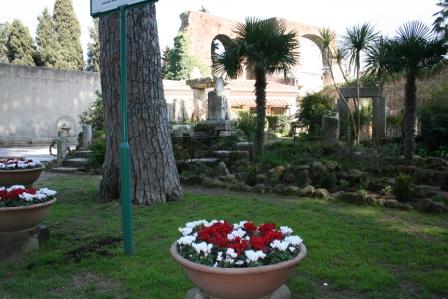
The big villa itself was once owned by the Mattei family, who laid out the park and had the obelisk erected, intending it to be the focal point of a planned (but unrealised) mock-Classical complex which would even have included a Greek theatre. It is now used by the Italian Geographical Society. Turn to the left as you enter the park, and keep bearing in that direction: you will soon spot the final obelisk, newly restored in a lovely little corner for sitting.
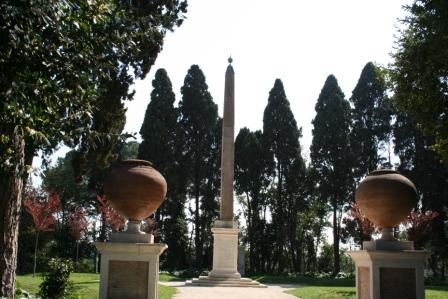
13. VILLA CELIMONTANA Obelisk
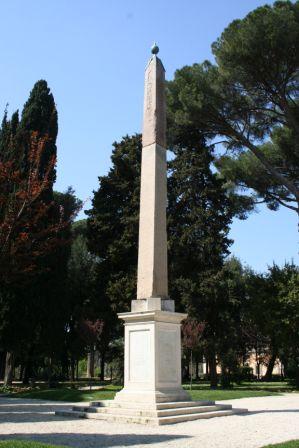
From the tallest spire in Rome you are now looking at the shortest - although this isn't immediately obvious as it has been mounted on an 'extension' - a plain shaft carved to give it more than double the original height. This was another of the obelisks which stood at the Iseum (in fact, the 'twin' -non-identical, being shorter! - of the one that you saw outside the Pantheon in Piazza della Rotonda). It is an Egyptian original, from the Temple of Ra at Heliopolis: cartouches on it refer to Rameses II. After being rediscovered near the temple of Isis, it was moved to stand on the Capitoline Hill next to the church of S Maria in Aracoeli; when Michelangelo redesigned the square it was acquired by the Mattei family as mentioned above, who erected it in 1582; at some stage however it must have fallen and broken, as it was restored from fragments and moved to its present position in the park by its new owner, Prince Godoy, in the 1820s. Until quite recently it was in a poor state, surrounded by scaffolding; fortunately now it has been made safe once more.
There are two somewhat unusual details about it: of all the obelisks standing in the city, this is the only one to have kept just its bronze ball at the summit (rather than being de-paganised with a cross); and at its restoration in 1820 an unfortunate accident occurred whereby one of the workmen had his hands crushed beneath it when the lowering-rope mechanism gave way - the story goes that they are still there today! ("Should've gone to Fontana's!") Whether these macabre additions were removed (or found at all) at its most recent restoration over the last few years, I'm afraid I can't tell you.
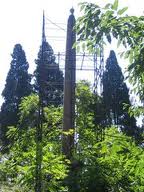
Twenty years ago, there would have been one more leg of the trail to go… We would have crossed the park, and descended an incredibly evocative old street under a succession of small brick archways, whose name, the 'Clivo di Scauro' is practically unchanged since ancient times.
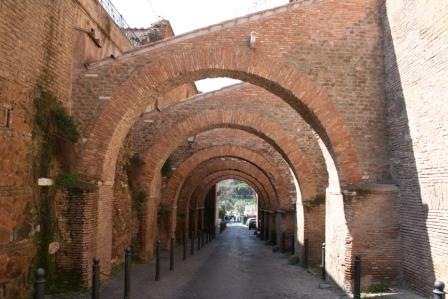
There are other important stops on this route (for future description), but the Clivo ends at the foot of the Palatine Hill, near where it overlooks the Circus Maximus. At Porta Capena, the Circus's south-east end, used to stand the Obelisk of Axum, in front of the headquarters of the UN's Food and Agriculture Organization. Previously this had housed the Italian Colonial Ministry, an appropriate place for the shaft to stand as it had been taken from Ethiopia during their colonial campaigns in the 1930s.
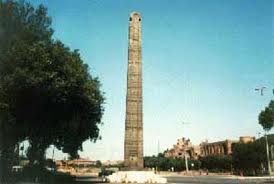
The obelisk, after much prevarication - being taken down, re-erected, struck by lightning, broken into pieces, stored away, reassembled, put up and taken down again - was finally returned to Ethiopia in 2005.

If you stretch over the wall at the far left corner of the Villa Celimontana park, you can just about see the place where it used to stand.
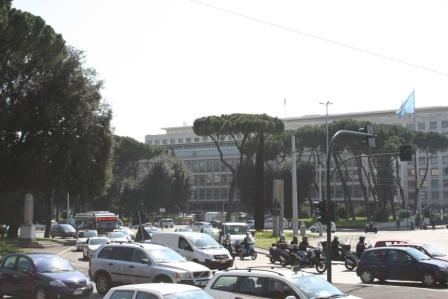
From here, to return to the city-centre, walk back to the entrance (the loos are a little way further down past the gates!) and turn back past the front of S Maria in Domnica. You pass the entrance to a narrow street to the left (which also in fact leads to the Clivo di Scauro) and here too stands what is known as the Arch of Dolabella. The main road downhill (Via Claudia) will bring you in 10 minutes to the Colosseum, where there is a Metro station; or to save some energy (finally...!) jump back on a 117 bus to return to the Corso, or a number 81 (the stop for both of these is a short way down Via Claudia), and let it take you the whole way back to Piazza Venezia via the Colosseum and the Circus Maximus.
